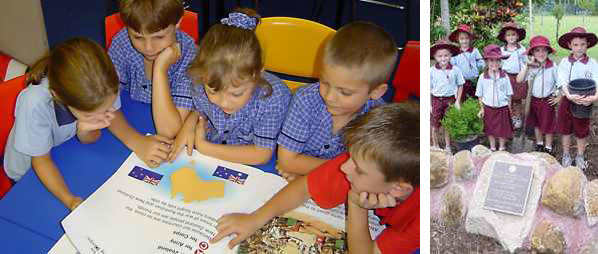
Why should young children learn about ANZAC Day?
Learning about ANZAC Day helps young children to understand the life and times of Australia and its people.
By building young children’s understandings about the traditions, facts and folklore of ANZAC Day, the many real life stories of sacrifices and heroism of everyday Australians will not be lost, but be handed down to future generations.
Research in education tells us that children learn best when they are highly interested, active and help make decisions about their learning. Young children have a fascination with all things to do with the past. By learning through hands-on, sensory and real-life experiences about ANZAC Day, young children will have an opportunity to understand the importance of this national day, and its role in building peace in communities today.
What will young children learn when they investigate ANZAC Day?
Studies of Society and Environment key learning area strands
Note: Refer to the Queensland Years 1 to 10 Studies of Society and Environment syllabus and supporting curriculum documents for further information. See the Queensland Studies Authority website at www.qsa.qld.edu.au/
Description of types of active learning about ANZAC Day
Please note that these descriptions of active learning about ANZAC Day will also connect well with quality, inquiry-based preschool/preparatory programs.
Time, Continuity and Change
Children look closely at, feel and talk about a range of artefacts about ANZAC Day, e.g. medals, photographs, parts of uniforms, copies of soldiers/families’ letters and ration items. Children talk with family/community members about what life was like during times of war. They compare how life is different during times of peace and war, and how war affects people.
Place and Space
Through making simple maps, e.g. relief and drawing, children learn about the landscape and of the distance travelled by the ANZACS to reach Gallipoli, Turkey, the Middle East, Belgium and France. They begin to understand the significance of some of the symbols that relate to the commemoration of ANZAC Day, including the poppy flowers that grew in the Belgian fields during and after the war.
Culture and Identity
Through conversations with family/community members, children learn about the range of roles and responsibilities of men, women and animals during wartimes and peacekeeping efforts. Children begin to understand the importance of ‘mateship’ as the ‘Diggers’ showed caring, compassion and friendship towards their mates as they battled in the trenches, in the air and on the sea. Children set up playspaces, e.g. hospital tent, plane hangar, submarine to roleplay their understandings about wartime roles/responsibilities of men/women in defence forces. To build understandings about the life of soldiers in battlefields, children may plan and cook a typical meal, e.g. cook hard tack (biscuits), eat bully beef (canned meat) and drink black tea
Systems, Resources and Power
Children join in school, class and family activities about ANZAC Day, e.g. marching in community ANZAC Day parades, making and laying of wreaths, and selling of ANZAC Day badges and poppies. With teacher support, children may plan for and prepare a special morning tea/lunch gathering with past and present Defence Force personnel from the local community. They may provide ideas about the design of a school/community ANZAC Day memorial project, e.g. monument, plaque, wall mural or special garden.
What quality information and resources will assist teachers when planning programs about ANZAC Day?
On this website there are considerable resources giving background and detailed information on conflicts relating to ANZAC Day. The best start point for this information is accessible here.
The ANZAC Day Commemoration Committee of Queensland has developed a range of early childhood kits, big books and shelf books for children’s and teachers’ use, including the following which are available for purchase here:
A is for ANZACs (shelf book)
Peace in Our Communities -- a teaching and learning package for primary schools (children’s peace posters, list of strategic questions, CD-ROM of teachers’ manual, all presented in a large folder)
Lt Cdr Henry Stoker -- an Historic Journey. The AE2 and the Gallipoli Campaign
Simpson and Duffy (big book, shelf book, CD-ROM of teachers’ manual)
Walers Go to War (shelf book)
Why are they marching, Daddy? (big book, shelf book and kit -- big book, teachers’ manual, picture/word cards, CD-ROM of narrated story)
Additional useful website on ANZAC Day for early childhood include:
Australia’s Culture and Recreation – ANZAC Day Quick Facts, links to other ANZAC Day websites
Visit Gallipoli
Australian War Memorial education pages -- extensive photograph database
Department of Veterans’ Affairs, Education resources
Education Network Australia online -- ANZACs and ANZAC Day
Finding out about ANZAC Day
To assist in building children's understandings of ANZAC Day, the Finding out about ANZAC Day sections may be explored before beginning the Activities listed. Other early childhood resources published by the ANZAC Day Commemoration Committee and listed earlier on this page will also provide excellent teaching/learning materials to help explore the topic of ANZAC Day.





